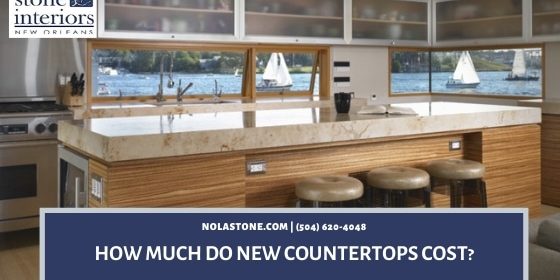Getting a quote on new countertops might sound straightforward (measure the kitchen, measure the stone, done and done). But those who have done their research will quickly learn that it’s not that easy.
The price of new countertops depends on a range of factors, including:
-
Whether you’re paying by the square foot or by the slab
-
Material type
-
Seam location
-
Inconsistencies across the slab
-
Entryway and space constraints
If you’re wondering how your stone fabricator figures it all out, here’s a glimpse into everything they need to consider.

Paying by the Square Foot or by the Slab
Stone fabricators with limited inventory typically charge by the slab. In this case, even if you only need to use a portion of the slab, you’ll likely end up paying for the whole thing. Special order material will almost always be charged by the slab, so that the fabricator doesn’t have to take on the cost of unused material.
Larger fabricators (such as Stone Interiors) that keep a wide variety of colors in stock are often able to charge by the square foot. They factor all the variables (like the fabrication equipment needed for that material) into the square foot price, making it fairly easy to calculate the homeowner’s final cost.
Material Type
The type of material you choose (granite, marble, etc.) has a huge impact on both the slab and square foot price. Some materials are more difficult to extract, fabricate, or transport, giving them a higher price tag.
If you’re paying by the slab, the type of material could also affect the number of slabs needed for your job. For the sake of safe handling, every material has a limited slab size: an engineered quartz slab may come in different standard sizes than granite or marble slabs.
The strength of the material could also determine how large the slab can be, and therefore, how many slabs need to be used for the job. Certain materials come in smaller sizes, simply because they have a higher risk of breaking during transportation.
Seam Location
Your stone fabricator will likely talk to you about seam placement before they can give you an accurate quote.
If the material you’ve chosen has a very consistent pattern, then seam location may not be a concern. No matter where the separate countertop pieces are cut from the slabs, the pattern will be uniform across the seams.
But if you choose a material with a lot of color variation and patterning, then a typical slab layout (one that maximizes material usage) may not give you the most attractive seam transitions.
If you’re interested in getting the best “vein match” at seams for a material with a lot of variation, ask your fabricator if you can purchase a digital layout. Advanced fabricators can use software to import slab photos and your countertop dimensions, allowing them to plan and visualize the best possible locations for your seams.
A digital layout usually comes with an added fee, and you may need to purchase additional material to achieve the perfect look. But many homeowners choose this option in order to visualize their space before fabrication, and have the peace of mind that they’ll love their countertops for years to come.
Inconsistencies Across the Slab
Although one slab may be large enough to get the job done, there are often veins, inconsistencies or imperfections in the slab. This is especially likely in natural stones like granite, marble, and quartzite.
Viewing the slab in person, if possible, is always a good idea. Natural stone (even after it’s been polished) can have different surface textures, as well as small pits and fissures. Engineered quartz slabs may also have small variation in patterning.
Many homeowners appreciate the natural, unique characteristics of the stone, and prefer to keep these features in their finished countertop. Others prefer to avoid them. Seeing the slab before fabrication allows you to identify the features that you want as a focal point, or eliminate them from your job entirely.
Entryways and Space Constraints
It’s easy to dream up a gorgeous, expansive kitchen island – but someone has to get that thing in the door.
In some cases, one slab might be large enough to fabricate your entire island without any seams. But if it’s too large for the entryway, a seam will be added in order to transport and install the island in the home.
The Measure Technician who visits your home will take all of this into consideration before giving you a final quote.
These are just a few factors that impact the final cost of your countertops. Unfortunately, it’s not as easy as breaking out a tape measure and making some educated guesses. So it’s crucial that you hire a trustworthy professional to laser-measure your space and talk to you about your options before they make the first cut.
Now, for the fun part: choosing the perfect material for your countertop.








